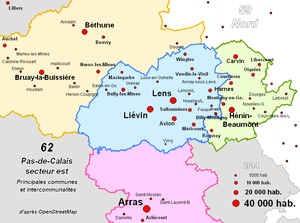Lens, Pas-de-Calais
| Lens | ||
|---|---|---|
|
Lens in late-July 2006 | ||
| ||
 Lens | ||
|
Location within Hauts-de-France region  Lens | ||
| Coordinates: 50°25′56″N 2°50′00″E / 50.4322°N 2.8333°ECoordinates: 50°25′56″N 2°50′00″E / 50.4322°N 2.8333°E | ||
| Country | France | |
| Region | Hauts-de-France | |
| Department | Pas-de-Calais | |
| Arrondissement | Lens | |
| Canton | Chief town of 3 cantons | |
| Intercommunality |
Communaupole de Lens-Liévin | |
| Government | ||
| • Mayor (2001–2008) | Guy Delcourt | |
| Area1 | 11.70 km2 (4.52 sq mi) | |
| Population (2012)2 | 32,663 | |
| • Density | 2,800/km2 (7,200/sq mi) | |
| Time zone | CET (UTC+1) | |
| • Summer (DST) | CEST (UTC+2) | |
| INSEE/Postal code | 62498 / 62300 | |
| Elevation | 27–71 m (89–233 ft) | |
|
1 French Land Register data, which excludes lakes, ponds, glaciers > 1 km² (0.386 sq mi or 247 acres) and river estuaries. 2 Population without double counting: residents of multiple communes (e.g., students and military personnel) only counted once. | ||
Lens (French pronunciation: [lɑ̃s]) is a commune in the Pas-de-Calais department in northern France. It is one of the main towns of Hauts-de-France along with Lille, Valenciennes, Amiens, Roubaix, Tourcoing, Arras and Douai. The inhabitants are called Lensois.
Metropolitan area
Lens belongs to the intercommunality of Lens-Liévin, which consists of 36 communes, with a total population of 250,000. Lens, along with Douai, forms the metropolitan area of Douai-Lens, whose population at the 1999 census was 552,682.[1]
History
Lens was initially a fortification from the Norman invasions. In 1180, it was owned by the Count of Flanders, and sovereignty was exercised by the Crown of France. In the 13th century, Lens received a charter from Louis VIII of France, allowing it to become a city. The Flemish razed the city in 1303. Prior to this, the city's population relied on its markets.[2] In 1526, Lens was made part of the Spanish Netherlands under the ownership of the French monarchy, and only passed back to France on 7 November 1659 with the Treaty of the Pyrenees.[3]
In 1849, coal was discovered in Lens after surveys were carried out at Annay, Courrières and Loos-en-Gohelle. This led to the expansion of the city into an important industrial center. The Lens Mining Company was founded in 1852 and experienced large profits.[4] The city was largely destroyed in the First World War and half of the population perished.[5] The Gare de Lens railway station, built in 1927, is served by regional trains towards Lille, Arras, Douai, Dunkirk, Calais and Valenciennes. In World War II, the Allies bombarded the city from the air, leaving 500 dead.[6] At Vimy, a small town very close to Lens, are the Vimy Memorial and Vimy Ridge. Since 2012, Lens has been the location of the Louvre-Lens.
Transport
Lens is connected to the TGV network, with high speed trains to Paris.
Sport
Football club RC Lens plays in the town. Their stadium, Stade Bollaert-Delelis, was used for UEFA Euro 1984, the 1998 FIFA World Cup and UEFA Euro 2016 and the 1999 Rugby World Cup and the 2007 Rugby World Cup.
Gallery
 East of Pas-de-Calais (Béthune, Lens, Hénin-Beaumont)
East of Pas-de-Calais (Béthune, Lens, Hénin-Beaumont) Lens church
Lens church Main shopping district
Main shopping district- One of the many cone-shaped coal tips that litter the landscape near Lens
See also
References
- ↑ OECD (8 August 2006). OECD Territorial Reviews OECD Territorial Reviews: France 2006. OECD Publishing. p. 95. ISBN 978-92-64-02266-9.
- ↑ "Medieval era". Ville de Lens. Retrieved 1 August 2015.
- ↑ "Modern era". Ville de Lens. Retrieved 1 August 2015.
- ↑ "Discovery of Coal". Ville de Lens. Retrieved 1 August 2015.
- ↑ "World War I". Ville de Lens. Retrieved 1 August 2015.
- ↑ "World War II". Ville de Lens. Retrieved 1 August 2015.
External links
| Wikimedia Commons has media related to Lens (France). |
- Official web site (French)
- Communauté d'Agglomeration of Lens-Liévin (French)

.svg.png)